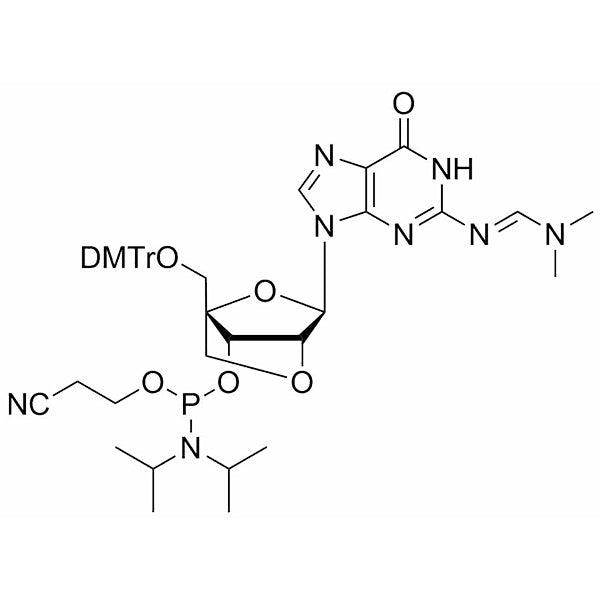2'-O-4'-C-Locked-G(dmf) Phosphoramidite
2'-O-4'-C-Locked-G(dmf) Phosphoramidite - N (Normal) / 0.25g / 30mL screwed bottle-28 is backordered and will ship as soon as it is back in stock.
Couldn't load pickup availability
Shipping notes
Shipping notes
Related Products
Details
Details
Basic Information
Locked Nucleic Acid (LNA) was first described by Wengel and coworkers in 1998 as a novel class of conformationally restricted oligonucleotide analogs
LNA is a bicyclic nucleic acid in which a ribonucleoside is linked to a methylene moiety between the 2'-oxygen and 4'-carbon atoms.
Oligonucleotides containing LNA exhibit unprecedented thermal stability to complementary DNA and RNA, allowing for excellent mismatch discrimination.
Application
LNA phosphoramidites, including 2'-O-4'-C-Locked-G(dmf) Phosphoramidite, offer multiple application due to their features:
- The high binding affinity of LNA oligos allows the use of short probes in applications such as SNP genotyping, allele-specific PCR and mRNA sample preparation.
- LNA is recommended for use in any hybridization assay that requires high specificity and/or reproducibility, such as double-labeled probes, in situ hybridization probes, molecular beacons, and PCR primers.
- LNA offers the ability to customize the Tm values of primers and probes in multiplexed assays.
As a result of these important properties, the use of LNA-modified oligos in antisense drug design is now being investigated, and recently the therapeutic potential of LNA has been explored.
Other Notes
LNA can be mixed with DNA and RNA, as well as other nucleic acid analogs, modifiers and labels. LNA oligonucleotides are water soluble and can be separated by gel electrophoresis and precipitated by ethanol.
Specifications
Specifications
-
Catalog No.PR2-005PR2-005PR2-005PR2-005PR2-005PR2-005PR2-005PR2-005
-
CAS No.709641-79-2709641-79-2709641-79-2709641-79-2709641-79-2709641-79-2709641-79-2709641-79-2
-
SMILESO=C1C(N=CN2[C@H]3[C@H](OC4)[C@H](OP(OCCC#N)N(C(C)C)C(C)C)[C@@]4(COC(C5=CC=CC=C5)(C6=CC=C(OC)C=C6)C7=CC=C(OC)C=C7)O3)=C2N=C(/N=C/N(C)C)N1O=C1C(N=CN2[C@H]3[C@H](OC4)[C@H](OP(OCCC#N)N(C(C)C)C(C)C)[C@@]4(COC(C5=CC=CC=C5)(C6=CC=C(OC)C=C6)C7=CC=C(OC)C=C7)O3)=C2N=C(/N=C/N(C)C)N1O=C1C(N=CN2[C@H]3[C@H](OC4)[C@H](OP(OCCC#N)N(C(C)C)C(C)C)[C@@]4(COC(C5=CC=CC=C5)(C6=CC=C(OC)C=C6)C7=CC=C(OC)C=C7)O3)=C2N=C(/N=C/N(C)C)N1O=C1C(N=CN2[C@H]3[C@H](OC4)[C@H](OP(OCCC#N)N(C(C)C)C(C)C)[C@@]4(COC(C5=CC=CC=C5)(C6=CC=C(OC)C=C6)C7=CC=C(OC)C=C7)O3)=C2N=C(/N=C/N(C)C)N1O=C1C(N=CN2[C@H]3[C@H](OC4)[C@H](OP(OCCC#N)N(C(C)C)C(C)C)[C@@]4(COC(C5=CC=CC=C5)(C6=CC=C(OC)C=C6)C7=CC=C(OC)C=C7)O3)=C2N=C(/N=C/N(C)C)N1O=C1C(N=CN2[C@H]3[C@H](OC4)[C@H](OP(OCCC#N)N(C(C)C)C(C)C)[C@@]4(COC(C5=CC=CC=C5)(C6=CC=C(OC)C=C6)C7=CC=C(OC)C=C7)O3)=C2N=C(/N=C/N(C)C)N1O=C1C(N=CN2[C@H]3[C@H](OC4)[C@H](OP(OCCC#N)N(C(C)C)C(C)C)[C@@]4(COC(C5=CC=CC=C5)(C6=CC=C(OC)C=C6)C7=CC=C(OC)C=C7)O3)=C2N=C(/N=C/N(C)C)N1O=C1C(N=CN2[C@H]3[C@H](OC4)[C@H](OP(OCCC#N)N(C(C)C)C(C)C)[C@@]4(COC(C5=CC=CC=C5)(C6=CC=C(OC)C=C6)C7=CC=C(OC)C=C7)O3)=C2N=C(/N=C/N(C)C)N1
-
Molecular FormulaC44H53N8O8PC44H53N8O8PC44H53N8O8PC44H53N8O8PC44H53N8O8PC44H53N8O8PC44H53N8O8PC44H53N8O8P
-
Molecular Weight852.93852.93852.93852.93852.93852.93852.93852.93
-
AppearanceOff-white to yellow powder,free from visible foreign matterOff-white to yellow powder,free from visible foreign matterOff-white to yellow powder,free from visible foreign matterOff-white to yellow powder,free from visible foreign matterOff-white to yellow powder,free from visible foreign matterOff-white to yellow powder,free from visible foreign matterOff-white to yellow powder,free from visible foreign matterOff-white to yellow powder,free from visible foreign matter
-
PurityHPLC≥98.0%HPLC≥98.0%HPLC≥98.0%HPLC≥98.0%HPLC≥98.0%HPLC≥98.0%HPLC≥98.0%HPLC≥98.0%
-
Storage Condition-20℃-20℃-20℃-20℃-20℃-20℃-20℃-20℃
-
Moisture ContentK.F.≤0.50% w/wK.F.≤0.50% w/wK.F.≤0.50% w/wK.F.≤0.50% w/wK.F.≤0.50% w/wK.F.≤0.50% w/wK.F.≤0.50% w/wK.F.≤0.50% w/w
Documentation
Documentation
Basic Information
Locked Nucleic Acid (LNA) was first described by Wengel and coworkers in 1998 as a novel class of conformationally restricted oligonucleotide analogs
LNA is a bicyclic nucleic acid in which a ribonucleoside is linked to a methylene moiety between the 2'-oxygen and 4'-carbon atoms.
Oligonucleotides containing LNA exhibit unprecedented thermal stability to complementary DNA and RNA, allowing for excellent mismatch discrimination.
Application
LNA phosphoramidites, including 2'-O-4'-C-Locked-G(dmf) Phosphoramidite, offer multiple application due to their features:
- The high binding affinity of LNA oligos allows the use of short probes in applications such as SNP genotyping, allele-specific PCR and mRNA sample preparation.
- LNA is recommended for use in any hybridization assay that requires high specificity and/or reproducibility, such as double-labeled probes, in situ hybridization probes, molecular beacons, and PCR primers.
- LNA offers the ability to customize the Tm values of primers and probes in multiplexed assays.
As a result of these important properties, the use of LNA-modified oligos in antisense drug design is now being investigated, and recently the therapeutic potential of LNA has been explored.
Other Notes
LNA can be mixed with DNA and RNA, as well as other nucleic acid analogs, modifiers and labels. LNA oligonucleotides are water soluble and can be separated by gel electrophoresis and precipitated by ethanol.
-
Catalog No.PR2-005PR2-005PR2-005PR2-005PR2-005PR2-005PR2-005PR2-005
-
CAS No.709641-79-2709641-79-2709641-79-2709641-79-2709641-79-2709641-79-2709641-79-2709641-79-2
-
SMILESO=C1C(N=CN2[C@H]3[C@H](OC4)[C@H](OP(OCCC#N)N(C(C)C)C(C)C)[C@@]4(COC(C5=CC=CC=C5)(C6=CC=C(OC)C=C6)C7=CC=C(OC)C=C7)O3)=C2N=C(/N=C/N(C)C)N1O=C1C(N=CN2[C@H]3[C@H](OC4)[C@H](OP(OCCC#N)N(C(C)C)C(C)C)[C@@]4(COC(C5=CC=CC=C5)(C6=CC=C(OC)C=C6)C7=CC=C(OC)C=C7)O3)=C2N=C(/N=C/N(C)C)N1O=C1C(N=CN2[C@H]3[C@H](OC4)[C@H](OP(OCCC#N)N(C(C)C)C(C)C)[C@@]4(COC(C5=CC=CC=C5)(C6=CC=C(OC)C=C6)C7=CC=C(OC)C=C7)O3)=C2N=C(/N=C/N(C)C)N1O=C1C(N=CN2[C@H]3[C@H](OC4)[C@H](OP(OCCC#N)N(C(C)C)C(C)C)[C@@]4(COC(C5=CC=CC=C5)(C6=CC=C(OC)C=C6)C7=CC=C(OC)C=C7)O3)=C2N=C(/N=C/N(C)C)N1O=C1C(N=CN2[C@H]3[C@H](OC4)[C@H](OP(OCCC#N)N(C(C)C)C(C)C)[C@@]4(COC(C5=CC=CC=C5)(C6=CC=C(OC)C=C6)C7=CC=C(OC)C=C7)O3)=C2N=C(/N=C/N(C)C)N1O=C1C(N=CN2[C@H]3[C@H](OC4)[C@H](OP(OCCC#N)N(C(C)C)C(C)C)[C@@]4(COC(C5=CC=CC=C5)(C6=CC=C(OC)C=C6)C7=CC=C(OC)C=C7)O3)=C2N=C(/N=C/N(C)C)N1O=C1C(N=CN2[C@H]3[C@H](OC4)[C@H](OP(OCCC#N)N(C(C)C)C(C)C)[C@@]4(COC(C5=CC=CC=C5)(C6=CC=C(OC)C=C6)C7=CC=C(OC)C=C7)O3)=C2N=C(/N=C/N(C)C)N1O=C1C(N=CN2[C@H]3[C@H](OC4)[C@H](OP(OCCC#N)N(C(C)C)C(C)C)[C@@]4(COC(C5=CC=CC=C5)(C6=CC=C(OC)C=C6)C7=CC=C(OC)C=C7)O3)=C2N=C(/N=C/N(C)C)N1
-
Molecular FormulaC44H53N8O8PC44H53N8O8PC44H53N8O8PC44H53N8O8PC44H53N8O8PC44H53N8O8PC44H53N8O8PC44H53N8O8P
-
Molecular Weight852.93852.93852.93852.93852.93852.93852.93852.93
-
AppearanceOff-white to yellow powder,free from visible foreign matterOff-white to yellow powder,free from visible foreign matterOff-white to yellow powder,free from visible foreign matterOff-white to yellow powder,free from visible foreign matterOff-white to yellow powder,free from visible foreign matterOff-white to yellow powder,free from visible foreign matterOff-white to yellow powder,free from visible foreign matterOff-white to yellow powder,free from visible foreign matter
-
PurityHPLC≥98.0%HPLC≥98.0%HPLC≥98.0%HPLC≥98.0%HPLC≥98.0%HPLC≥98.0%HPLC≥98.0%HPLC≥98.0%
-
Storage Condition-20℃-20℃-20℃-20℃-20℃-20℃-20℃-20℃
-
Moisture ContentK.F.≤0.50% w/wK.F.≤0.50% w/wK.F.≤0.50% w/wK.F.≤0.50% w/wK.F.≤0.50% w/wK.F.≤0.50% w/wK.F.≤0.50% w/wK.F.≤0.50% w/w
Why choose Hongene?
Trusted Partner in Nucleic Acid
Integrated Supply & Commercial Scale
With 26+ years of expertise, we control a secure supply chain for RNA raw materials and provide reliable GMP-grade oligo synthesis from research to commercial kilogram-scale production.
Proprietary Technology & IP
Our proprietary Chemoenzymatic Ligation Platform combines chemical andenzymatic methods, enabling high-putity, cost-effective, and large-scale production of RNA-based therapeutics.
Rigorous Quality
We implement multiple stringent QC steps, maintain ISO certifications, and ensure >99% batch-to-batch consistency, reducing scale-up and PPQ risks.
Manufacturing Scalability
Hongene operates 1.67 million sq. ft Oligonucleotide Manufacturing Facility, with advanced equipments including multiple OligoPilot™ and OligoProcess™ synthesizers (10-1800 mmol). 48 flexible production lines enable one-stop seamless scaling-up of API production from gram-level to tons and acheive high purity of 98%, meeting NMPA, FDA, and EMA standards.
Global Business Network
Our products and services reach over 40 countries and regions, supporting around 3,000 clients worldwide.


